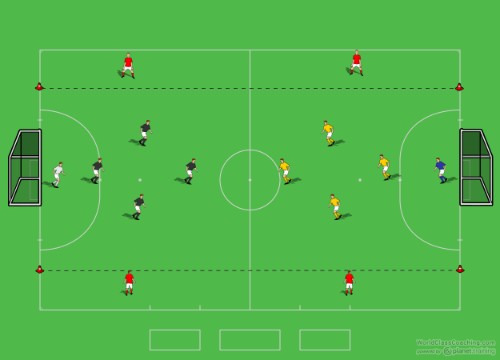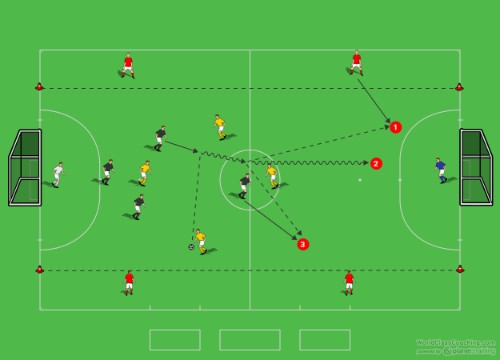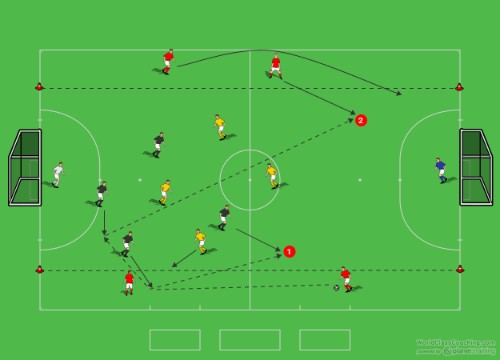By Sean Pearson
Area Size: 35 x 45 yards
Teams: 20 mins
Players: 5 v 5 + 4
Objectives
- For players to understand the triggers and moments of when to intercept
- To quickly identify how to move the ball forwards quickly
Set-Up
2 wide zones for the 4 neutrals and 2 teams in diamond formations to create more lines in each formation. Initially no central player is allowed in the wide zones but neutrals are allowed into the central area.

Execution
Both teams attack the opposition’s goal, the defending team sits deep and keeps the area around the goal compact. The defending team looks for specific triggers to anticipate intercepting a pass. The first trigger is when the body shape of the player on the ball opens up and looks to pass. Their head goes down and their hips open up. The defending players look for this body shape to anticipate intercepting the result of the pass.
The body shape is not the only trigger to look for nor should the interception be attempted every time a pass is played. 2 other triggers are if a pass is played square (or across the field) the other is the pace of the pass, if it is slow or mishit. When you see two or more of these triggers in a pass, mainly the body shape and angle of a square pass, this is the moment when players close to the receiving player can anticipate the interception.

Now a decision needs to be made for who to move the ball forward. 1) if there is a player further ahead and a pass is able to be played, so the team can counter attack quickly, play the pass. 2) if there is open space because the team, who lost possession, is out of position take the space by running with the ball. 3) if opposition players close down the intercepting player, can other players create options by moving away at angles to keep an attack going.
To help stop forward passes from neutrals, if teams are set up correctly in a compact formation they can now enter the wide zone to intercept passes to neutrals, either neutral to neutral or central player to neutral player.
First, in order to intercept a pass, the defending team must be in a defensive position. The widest central player must be slightly behind the neutral player. When you see the trigger of body shape of a pass to the neutral, the central player can now step forwards and across to intercept the pass. Then 1) can another player see the space in front and move into it to start the attack. 2) sometimes the first pass might have to come backwards initially. If an option, because of how high the opposition is, can you play over to the opposite wide neutral, who is allowed to come in field to receive. Also for game realism as this is happening encourage the full back to overlap to have more numbers in the counter attack.

You can even add conditions on the game by saying the team that starts with the ball is building the play and allowed as many passes as possible to create a scoring opportunity. If they score the keep the ball, if they miss then the teams switch. If the defending team wins possession only allow a select number of passes before a shot (4 or 5). If the players concentrate on the number of passes rather than the speed of the attack, remind them that you want them to think of getting the ball forward quickly.
Variations
- Make it more difficult to attack by using off sides
By Sean Pearson. Sean is also the author Coaching Team Shape in the 3-3-1, Coaching Team Shape in the 4-2-3-1 and Coaching Team Shape in the 4-3-3


